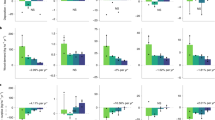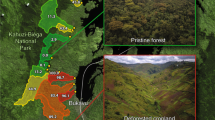Abstract
The mobilization of aluminium from acidic forest soils is arguably the most ecologically important consequence of acid deposition in the environment because of its adverse effects on soils, forest vegetation and surface water1,2,3. Here we show that there has been a significant decline in the concentrations of aluminium species in soil solutions at medium-to-high elevations in a northern hardwood forest in the United States in response to decreasing acidic deposition. Streamwater aluminium concentrations have also fallen and, if this rate of recovery persists, will within 10 years no longer pose a threat to fish.
This is a preview of subscription content, access via your institution
Access options
Subscribe to this journal
Receive 51 print issues and online access
$199.00 per year
only $3.90 per issue
Buy this article
- Purchase on Springer Link
- Instant access to full article PDF
Prices may be subject to local taxes which are calculated during checkout

Similar content being viewed by others
References
Cronan, C. S. & Grigal, D. F. J. Environ. Qual. 24, 209–226 (1995).
Driscoll, C. T. & Postek, K. M. in The Environmental Chemistry of Aluminum (ed. Sposito, G.) 363–418 (CRC, Boca Raton, Florida, 1996).
Bulger, A. J., Lien, L., Cosby, J. & Henriksen, A. Can. J. Fish. Aquat. Sci. 50, 575–585 (1993).
Likens, G. E., Driscoll, C. T. & Buso, D. C. Science 272, 244–246 (1996).
Driscoll, C. T. et al. BioScience 53, 180–198 (2001).
Stoddard, J. L. et al. Nature 401, 575–578 (1999).
Likens, G. E. et al. Biogeochemistry 41, 89–173 (1998).
Johnson, N. M., Driscoll, C. T., Eaton, J. S., Likens, G. E. & McDowell, W. J. Geochem. Cosmochim Acta 45, 1421–1437 (1981).
Driscoll, C. T., van Breemen, N. & Mulder, J. Soil Sci. Soc. Am. J. 49, 437–444 (1985).
Lawrence, G. B., Fuller, R. D. & Driscoll, C. T. Biogeochemistry 2, 115–135 (1986).
Author information
Authors and Affiliations
Corresponding author
Ethics declarations
Competing interests
The authors declare no competing financial interests.
Rights and permissions
About this article
Cite this article
Palmer, S., Driscoll, C. Decline in mobilization of toxic aluminium. Nature 417, 242–243 (2002). https://doi.org/10.1038/417242a
Issue Date:
DOI: https://doi.org/10.1038/417242a
This article is cited by
-
The Biogeochemistry of Carbon at Hubbard Brook
Biogeochemistry (2005)
-
Wood-ash recycling affects forest soil and tree fine-root chemistry and reverses soil acidification
Plant and Soil (2004)
Comments
By submitting a comment you agree to abide by our Terms and Community Guidelines. If you find something abusive or that does not comply with our terms or guidelines please flag it as inappropriate.



